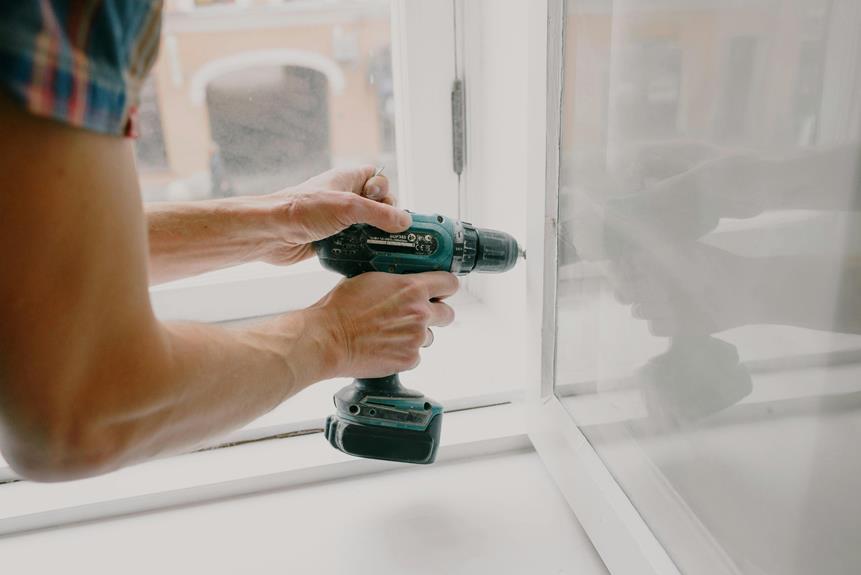Securing your home is crucial for the safety and well-being of your family. Budgeting for a home security system is an important step in this process. In this discussion, we will provide some tips to help you navigate the process of fortifying your residence without overspending.
By following these tips, you can create a budget-friendly plan to enhance the security of your home. Remember, investing in a home security system is an investment in the safety and peace of mind of your loved ones.

Assessing Your Security Needs
To properly assess your security needs, consider the specific vulnerabilities and risks your home may face. Evaluating security risks is crucial in determining the level of protection required for your home. Take into account factors such as the crime rate in your area, the accessibility of your property, and any previous incidents that may have occurred.
By identifying these vulnerabilities, you can better understand the potential threats to your home’s security.
Once you have evaluated the security risks, it’s important to determine your budget constraints. Allocating a budget for your home security system will help you make informed decisions about the level of protection you can afford. Consider not only the cost of the initial installation but also ongoing maintenance and monitoring fees.
Striking a balance between affordability and effectiveness is essential to ensure that your security system meets your needs without breaking the bank.
Researching Home Security Options
When researching home security options, it’s important to consider the specific features and capabilities that would best meet your needs. To find the right system for you, start by researching reputable brands in the market.
Look for companies that have a history of providing reliable and effective home security solutions. Reading customer reviews is also crucial as it gives you insights into the experiences of other homeowners who have used the products or services you are considering.
Take the time to compare different brands and their offerings. Consider factors such as the types of sensors and detectors they offer, the monitoring services available, and the integration with other smart home devices. This will help you determine which company offers the features that align with your security needs.
To assist you in your research, here is a table comparing four reputable home security brands:
| Brand | Features | Monitoring Services | Integration with Smart Home Devices |
|---|---|---|---|
| Brand A | Advanced sensors, 24/7 monitoring | Professional monitoring, self-monitoring options | Compatible with smart locks, cameras, and voice assistants |
| Brand B | High-resolution cameras, mobile app control | Professional monitoring, self-monitoring options | Integrates with smart thermostats, lights, and doorbell cameras |
| Brand C | Motion detection, two-way audio | Professional monitoring, self-monitoring options | Works with smart lights, door/window sensors, and video doorbells |
| Brand D | Wireless installation, remote access | Professional monitoring, self-monitoring options | Compatible with smart locks, cameras, and voice assistants |
Setting a Realistic Budget
One important step in planning your home security system is to establish a realistic budget. Setting a budget ensures that you know how much you can afford to spend on your security needs, helping you make informed decisions and avoid overspending.
Here are three cost-effective strategies to help you set a realistic budget for your home security system:
- Assess your security needs: Take the time to evaluate the vulnerabilities of your home and identify the areas that require extra security measures. This will help you prioritize your spending and focus on the most critical areas.
- Research different options: Explore the market for various home security systems and compare prices, features, and warranties. Consider both professional monitoring services and DIY options to find the most cost-effective solution that meets your needs.
- Consider long-term costs: While it’s important to find a system that fits your initial budget, also take into account the long-term costs. This includes monthly monitoring fees, maintenance, and potential upgrades. Opting for a system that offers flexibility and scalability can save you money in the long run.
Identifying Potential Cost-Saving Measures
Consider implementing cost-saving measures to reduce expenses associated with your home security system. By being mindful of your budget, you can still protect your home without spending too much. Here are some ways to save money and find budget-friendly solutions:
- Install the system yourself: By choosing to install the system on your own, you can save money on installation fees.
- Research discounts: Take the time to research discounts and compare prices from different providers. This will help you find the best deal for your budget.
- Opt for basic packages: Consider opting for basic packages that meet your needs without unnecessary features that can drive up the cost.
- Utilize existing equipment: If you already have a security system in place, you may be able to upgrade or add on to it instead of starting from scratch. This can save you money on equipment costs.
- Consider wireless systems: Wireless systems are often more cost-effective than wired ones, as they require less labor and materials for installation.
- Use motion sensor lights: Incorporating motion sensor lights into your security system can provide added protection while also saving energy costs. They deter potential intruders and are a cost-effective solution for outdoor security.
- Utilize smart home technology: Smart home technology can enhance your security system while also saving on energy costs. It allows you to control and monitor your system remotely, providing peace of mind.
Comparing Prices and Features
When comparing prices and features of home security systems, it’s important to make an informed decision that fits your needs and budget. Here are three key points to consider:
- Price comparison: Take the time to research and compare prices from different providers. Look out for any hidden fees or additional costs that may not be immediately apparent. Remember, the goal is to find a system that fits within your budget without compromising on quality.
- Feature analysis: Consider the specific features offered by each home security system. Do they include video surveillance, motion sensors, or access control? Think about your specific needs and prioritize the features that are most important to you. This will help you narrow down your options and choose a system that meets your requirements.
- Customer reviews: Before making a final decision, read customer reviews and testimonials. This will give you insight into the experiences of others who’ve used the home security system you’re considering. Pay attention to feedback regarding reliability, customer service, and ease of use. Hearing from others who’ve already invested in a particular system can provide valuable information to help you make the right choice.
Evaluating DIY Vs Professional Installation
Deciding between DIY and professional installation for your home security system requires careful consideration of your skills, available time, and budget.
DIY installation can be a cost-effective option if you’re handy and have some technical skills. It allows you to save money on installation fees and gives you full control over the setup process. DIY systems are typically easy to install and can be customized to meet your specific needs.
On the other hand, professional installation offers convenience and peace of mind. Trained technicians will handle the entire setup process for you, ensuring correct installation and optimal functioning. However, professional installation often comes with a higher price tag.
When comparing costs, remember to consider both upfront expenses and ongoing maintenance costs. DIY systems may require occasional troubleshooting and repairs, which can incur additional expenses over time.
Ultimately, the choice between DIY and professional installation depends on your circumstances. Assess your skills, available time, and budget to make an informed decision that provides the home security you desire.
Understanding Ongoing Monitoring Costs
To fully grasp the expenses associated with ongoing monitoring of your home security system, it’s important to carefully review and compare the pricing structures offered by different security companies. This will help you make an informed decision and ensure that you get the best value for your money.
Here are three key factors to consider when evaluating ongoing monitoring costs:
- Contract Terms: Before signing up for a monitoring service, make sure you understand the contract terms. Some companies may require a long-term commitment, while others offer more flexible options. Take the time to read the fine print and ask questions to avoid any surprises down the line.
- Reliability of Monitoring Services: The main purpose of a home security system is to protect your property and loved ones. Therefore, it’s crucial to choose a monitoring service that’s reliable and responsive. Look for companies with a proven track record in the industry and check customer reviews to get an idea of their reliability.
- Pricing Structures: Different security companies may have varying pricing structures for their monitoring services. Some may charge a monthly fee, while others may offer a bundled package that includes monitoring and other services. Compare the costs and benefits of each option to determine which one best fits your budget and needs.
Considering Equipment and System Upgrades
Now that you have a clear understanding of the ongoing monitoring costs for your home security system, let’s talk about the importance of considering equipment and system upgrades.
Maintaining your equipment is crucial to ensure the reliability of your home security system. Regularly checking the batteries, sensors, and other components can prevent malfunctions or breakdowns that could compromise the security of your home.
Upgrading your system is also worth considering for improved reliability. With advancing technology, newer systems offer enhanced features and better performance.
By upgrading, you can enjoy advanced video surveillance, integrated smart home capabilities, and remote access control, all of which contribute to better protection for your home. This upgrade will provide you with peace of mind, knowing that your property and loved ones are well-protected.
In addition to enhanced security, upgrading your system can also offer increased convenience. Modern systems often come with user-friendly interfaces and mobile applications that allow you to monitor and control your security system from anywhere, at any time. This level of accessibility makes managing your security system effortless and efficient.
Considering equipment maintenance and system upgrades is essential to ensure the reliability and effectiveness of your home security system.
Exploring Financing and Payment Options
When it comes to financing your home security system, it’s important to explore different options that can make the cost more manageable. Here are three options to consider:
- Financing through the security company: Many security companies offer financing options that allow you to spread out the cost of your system over time. This can help make the upfront cost more affordable for you.
- Credit card payment plans: If you have a credit card with a low-interest rate or a promotional offer, you can use it to finance your home security system. Look for credit cards that offer extended interest-free periods or low-interest rates to minimize the overall cost.
- Home equity loans or lines of credit: If you have equity in your home, you may be able to use it to finance your security system. Home equity loans and lines of credit typically offer lower interest rates compared to other financing options, making them an attractive choice.
Factoring in Maintenance and Warranty Expenses
When you’re planning your budget for a home security system, it’s important to consider the costs of maintenance and warranty coverage. While the initial installation cost is significant, ongoing maintenance expenses and the protection provided by a warranty are equally important.
Maintenance expenses for your security system can include regular inspections, system updates, and repairs. These costs will vary depending on the type and complexity of the system you choose. It’s a good idea to allocate a portion of your budget for these ongoing expenses to ensure that your security system remains in optimal working condition.
In addition, having warranty coverage is crucial for protecting your investment. A warranty provides peace of mind knowing that any necessary repairs or replacements will be covered by the manufacturer.
When budgeting for your home security system, it’s essential to consider the length and extent of the warranty coverage offered. Some warranties may only cover specific components or have limited durations, while others may provide comprehensive coverage for an extended period.
To help you understand the importance of factoring in maintenance and warranty expenses, here’s a simple table outlining the potential costs:
| Maintenance Expenses | Warranty Coverage |
|---|---|
| Regular inspections | Repairs and upgrades |
| System updates | Replacement parts |
| Repairs | Technician services |
Planning for Long-Term Security Needs
To ensure the ongoing effectiveness and reliability of your home security system, it’s important to plan for your long-term security needs. As technology continues to evolve, so do long-term security trends and home security advancements. By considering these factors, you can ensure that your home remains protected for years to come.
Here are three key considerations for planning your long-term security needs:
- Stay informed about long-term security trends: Keeping up with the latest advancements in home security technology is crucial. Stay informed about emerging trends such as smart home integration, artificial intelligence, and biometric authentication. This will help you make informed decisions when upgrading or expanding your security system.
- Future-proof your system: When investing in a home security system, choose flexible and scalable solutions. This allows you to easily integrate new technologies and expand your system as your needs change over time. Consider systems that are compatible with future advancements, such as wireless connectivity and cloud storage.
- Regular system updates and maintenance: Home security systems require regular updates and maintenance to ensure optimal performance. Schedule regular check-ups with your security provider to inspect and update your system. This will help identify any vulnerabilities and ensure that your system is up-to-date with the latest security patches.
Conclusion
Now that you have these tips to budget for a home security system, you can confidently protect what matters most to you.
By assessing your needs, researching options, and setting a realistic budget, you can find the perfect security solution without spending too much.
Remember to compare prices, consider upgrades, and explore financing options for extra savings.
With proper planning and a little investment, you can sleep peacefully knowing your home is secure.









